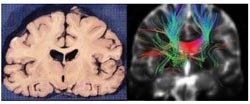New techniques for cerebral white matter fiber tracing

Comparison between coronal anatomy and fiber tracking results of the patient with cerebral infarction. Credit: Neural Regeneration Research<br>
In deterministic algorithms, scholars proposed the fiber assignment by continuous tracking algorithm, the tensor deflection algorithm, the tensorline algorithm.
Deterministic algorithms track fibers mainly depending on diffusion direction; however, they are susceptible to noise and partial volume effects, which result in the accumulation of tracking errors. Probabilistic algorithms can effectively reduce noise and partial volume effects, thus decreasing the accumulated errors and providing more fiber orientations.
Unfortunately, their calculations are very complicated, time-consuming and easy to produce additional ambiguous fibers, which make the application of these algorithms difficult. In response to these phenomena, Shan Jiang and colleagues from School of Mechanical Engineering, Tianjin University proposed the tri-linear interpolation algorithm for white matter fiber tracking.
A recent study from Jiang et al, published in the Neural Regeneration Research (Vol. 8, No. 23, 2013), selected a patient with acute infarction of the right basal ganglia and designed experiments based on either the tri-linear interpolation algorithm or tensorline algorithm. Fiber tracking in the same regions of interest (genu of the corpus callosum) was performed separately. The validity of the tri-linear interpolation algorithm was verified by quantitative analysis, and its feasibility in clinical diagnosis was confirmed by the contrast between tracking results and the disease condition of the patient as well as the actual brain anatomy.
Statistical results showed that the maximum length and average length of the white matter fibers tracked by the tri-linear interpolation algorithm were significantly longer. The tracking images of the fibers indicated that this method can obtain smoother tracked fibers, more obvious orientation and clearer details. Tracking fiber abnormalities are in good agreement with the actual condition of patients, and tracking displayed fibers that passed though the corpus callosum, which was consistent with the anatomical structures of the brain. Therefore, the tri-linear interpolation algorithm can achieve a clear, anatomically correct and reliable tracking result.
Article: ” Tri-linear interpolation-based cerebral white matter fiber imaging,” by Shan Jiang1, Pengfei Zhang1, Tong Han2, Weihua Liu1, Meixia Liu1 (1 School of Mechanical Engineering, Tianjin University, Tianjin 300072, China; 2 Medical Image Evaluation Center, Tianjin Huanhu Hospital, Tianjin 300060, China)
Jiang S, Zhang PF, Han T, Liu WH, Liu MX. Tri-linear interpolation-based cerebral white matter fiber imaging. Neural Regen Res. 2013;8(23):2155-2164.
Contact: Meng Zhao
eic@nrren.org
86-138-049-98773
Neural Regeneration Research
http://www.nrronline.org/
Full text: http://www.sjzsyj.org/CN/article/downloadArticleFile.do?attachType=PDF&id=687
Media Contact
More Information:
http://www.nrronline.org/All latest news from the category: Life Sciences and Chemistry
Articles and reports from the Life Sciences and chemistry area deal with applied and basic research into modern biology, chemistry and human medicine.
Valuable information can be found on a range of life sciences fields including bacteriology, biochemistry, bionics, bioinformatics, biophysics, biotechnology, genetics, geobotany, human biology, marine biology, microbiology, molecular biology, cellular biology, zoology, bioinorganic chemistry, microchemistry and environmental chemistry.
Newest articles

Trotting robots reveal emergence of animal gait transitions
A four-legged robot trained with machine learning by EPFL researchers has learned to avoid falls by spontaneously switching between walking, trotting, and pronking – a milestone for roboticists as well…

Innovation promises to prevent power pole-top fires
Engineers in Australia have found a new way to make power-pole insulators resistant to fire and electrical sparking, promising to prevent dangerous pole-top fires and reduce blackouts. Pole-top fires pose…

Possible alternative to antibiotics produced by bacteria
Antibacterial substance from staphylococci discovered with new mechanism of action against natural competitors. Many bacteria produce substances to gain an advantage over competitors in their highly competitive natural environment. Researchers…





















